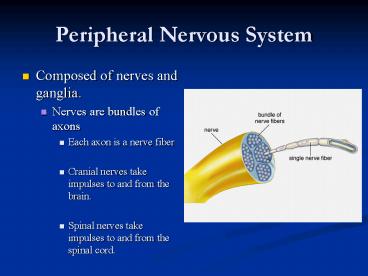Peripheral Nervous System - PowerPoint PPT Presentation
1 / 13
Title:
Peripheral Nervous System
Description:
Each axon is a nerve fiber. Cranial nerves take ... Somatic system includes nerves that take sensory information from external ... Innervate all internal organs ... – PowerPoint PPT presentation
Number of Views:1927
Avg rating:3.0/5.0
Title: Peripheral Nervous System
1
Peripheral Nervous System
- Composed of nerves and ganglia.
- Nerves are bundles of axons
- Each axon is a nerve fiber
- Cranial nerves take impulses to and from the
brain. - Spinal nerves take impulses to and from the
spinal cord.
2
Cranial and Spinal Nerves
3
Somatic System
- Somatic system includes nerves that take sensory
information from external sensory receptors to
the CNS and motor commands away from the CNS to
the skeletal muscles. - Voluntary control of skeletal muscle
- Reflexes are automatic responses to a stimulus.
- Does not require cortical processing
- Involuntary
- Protective function
4
Reflex Arc
5
Autonomic System
- Autonomic system regulates the activity of
cardiac and smooth muscles and glands. - Similar features of sympathetic and parasympathic
divisions - Function automatically, usually involuntary
- Innervate all internal organs
- Comprised of a preganglionic neuron, ganglia, and
a postganglionic neuron
6
Autonomic System
- Sympathetic division brings about fight or flight
responses. - Thoracolumbar origin
- Role of sympathetic chain ganglia
- Neurotransmitter norepinephrine (similar in
structure to adrenalin) - Parasympathetic division brings about relaxed
responses. - Cranial and sacral origin
- Neurotransmitter acetylcholine
7
(No Transcript)
8
Drug Abuse
- Drugs that affect the nervous system have two
general effects. - Impact limbic system.
- Promote or decrease action of a particular
neurotransmitter. - Drug abuse is apparent when a person takes a drug
at a dose level and under circumstances that
increase the potential for a harmful effect.
9
Drug Actions at a Synapse
10
Drug Abuse
- Alcohol.
- May affect GABA and Glutamate
- Overuse leads to decreased fat metabolism, fat
build up in the liver and liver damage - Nicotine.
- Causes neurons to release dopamine.
- Excess dopamine has reinforcing effect that leads
to dependence. - Regular use increased nicotine receptors in the
brain - Stimulant for neurons and other cells (cardiac)
- Cocaine.
- Prevents synaptic uptake of dopamine.
- Continued use causes body to produce less
dopamine. - Rush sensation followed by arousal followed by a
crash - Overuse can lead to seizures, cardiac and
respiratory arrest - Long term brain damage, link to Parkinsonss
disease
11
Drug Abuse
- Heroin.
- Binds to receptors meant for endorphins.
- Derived from morphine
- 3-6 minutes, relief from pain and feeling of
euphoria - Continued use causes body to produce fewer
endorphins. - Overuse can lead to hallucinations, mental and
emotional disorders - Marijuana.
- Binds to receptor for anandamide.
- Active chemical is THC or tetrahydrocannabinol
- Mild euphoria, alters sensory perception
- Brain impairment? Medicinal Benefits?
12
Degenerative Nervous System Diseases
- Alzheimer disease.
- Presence of abnormal neurons.
- Plaques.
- Neurofibrillary tangles.
- Parkinson disease.
- Overactive basal nuclei due to the degeneration
of dopamine-releasing neurons in the brain.
13
(No Transcript)































